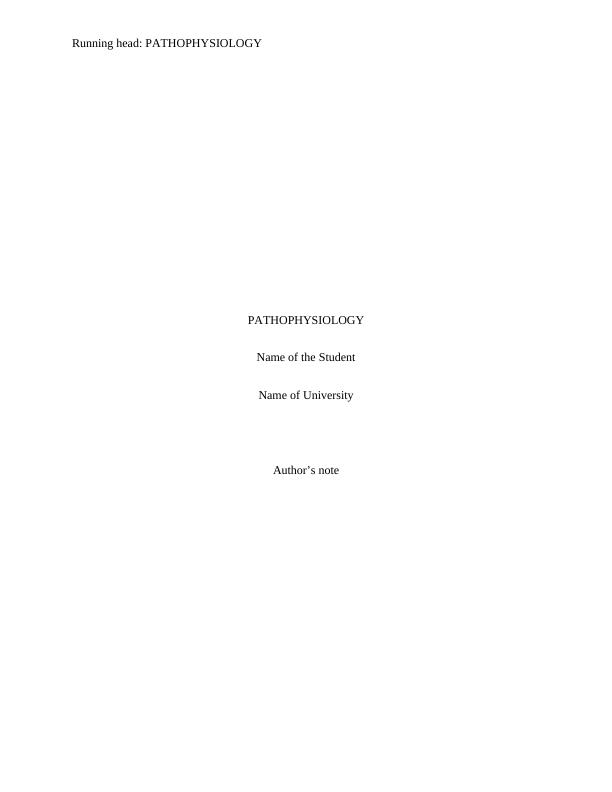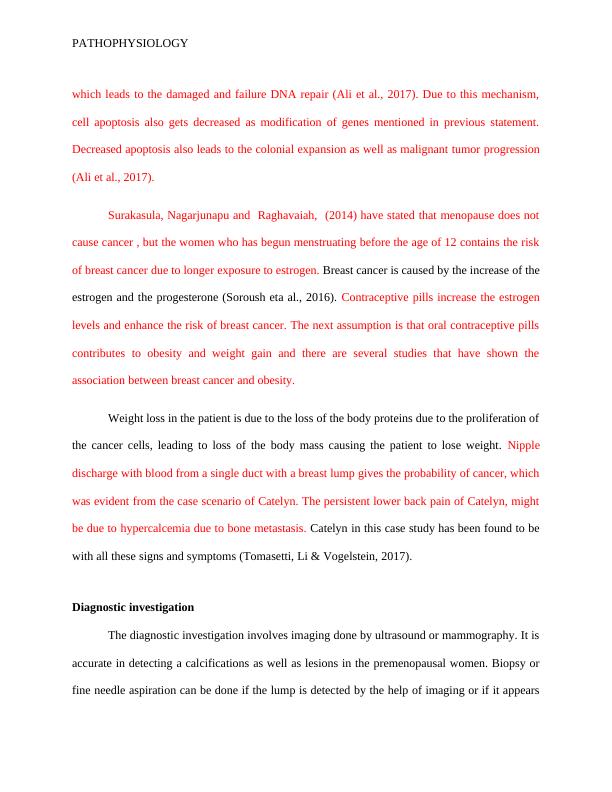Pathophysiology of Breast Cancer: Risk Factors and Mechanisms
Added on 2023-04-10
6 Pages1075 Words341 Views
Running head: PATHOPHYSIOLOGY
PATHOPHYSIOLOGY
Name of the Student
Name of University
Author’s note
PATHOPHYSIOLOGY
Name of the Student
Name of University
Author’s note

PATHOPHYSIOLOGY
Risk factors
The case study reveals that Catelyn had been taking oral contraceptive pills since last
three years. The association of breast cancer and oral contraceptive pill is under controversy,
however, some studies have conformed the carcinogenic impact of the product. Some of the
other risk factors associated with breast cancer which can be understood from the case study is
the age of individual, nipple discharge and gender. Breast cancer is common for Catelyn’s age as
the cells are exposed to estrogen and the other hormones causing the risk of breast cancer
(Santen, 2014).
Pathophysiology
It is evident from the study that the estrogen has effect on the breast cancer. From the
case study, it can be seen Catelyn is in premenopausal stage which signifies that estrogen and
progesterone are still active in her body. Estrogen has two receptors, alpha (α) and beta (β) and
both of them carries DNA binding domain. Estrogen has proliferative properties and due to that
it has negative impact on these receptors (Huang, Warner & Gustafsson, 2015). These changes
made the cells proliferate uncontrollably and this unregulated growth leads to the colonial
expansion of the cells. From the case study it can be seen that patient is receiving lymph node
radiation. Hence, it can be stated that this colonial expansion is spread through lymphatic
haematogenous mechanism which lead to the progression of malignant tumor (Huang, Warner &
Gustafsson, 2015. DNA damage response is a critical activities which is vital for the prevention
of the spread of this kind of malignant tumor. The patient has been receiving radiation for three
years and this radiation might lead to the changes in the inhibitors of DNA damage response
Risk factors
The case study reveals that Catelyn had been taking oral contraceptive pills since last
three years. The association of breast cancer and oral contraceptive pill is under controversy,
however, some studies have conformed the carcinogenic impact of the product. Some of the
other risk factors associated with breast cancer which can be understood from the case study is
the age of individual, nipple discharge and gender. Breast cancer is common for Catelyn’s age as
the cells are exposed to estrogen and the other hormones causing the risk of breast cancer
(Santen, 2014).
Pathophysiology
It is evident from the study that the estrogen has effect on the breast cancer. From the
case study, it can be seen Catelyn is in premenopausal stage which signifies that estrogen and
progesterone are still active in her body. Estrogen has two receptors, alpha (α) and beta (β) and
both of them carries DNA binding domain. Estrogen has proliferative properties and due to that
it has negative impact on these receptors (Huang, Warner & Gustafsson, 2015). These changes
made the cells proliferate uncontrollably and this unregulated growth leads to the colonial
expansion of the cells. From the case study it can be seen that patient is receiving lymph node
radiation. Hence, it can be stated that this colonial expansion is spread through lymphatic
haematogenous mechanism which lead to the progression of malignant tumor (Huang, Warner &
Gustafsson, 2015. DNA damage response is a critical activities which is vital for the prevention
of the spread of this kind of malignant tumor. The patient has been receiving radiation for three
years and this radiation might lead to the changes in the inhibitors of DNA damage response

PATHOPHYSIOLOGY
which leads to the damaged and failure DNA repair (Ali et al., 2017). Due to this mechanism,
cell apoptosis also gets decreased as modification of genes mentioned in previous statement.
Decreased apoptosis also leads to the colonial expansion as well as malignant tumor progression
(Ali et al., 2017).
Surakasula, Nagarjunapu and Raghavaiah, (2014) have stated that menopause does not
cause cancer , but the women who has begun menstruating before the age of 12 contains the risk
of breast cancer due to longer exposure to estrogen. Breast cancer is caused by the increase of the
estrogen and the progesterone (Soroush eta al., 2016). Contraceptive pills increase the estrogen
levels and enhance the risk of breast cancer. The next assumption is that oral contraceptive pills
contributes to obesity and weight gain and there are several studies that have shown the
association between breast cancer and obesity.
Weight loss in the patient is due to the loss of the body proteins due to the proliferation of
the cancer cells, leading to loss of the body mass causing the patient to lose weight. Nipple
discharge with blood from a single duct with a breast lump gives the probability of cancer, which
was evident from the case scenario of Catelyn. The persistent lower back pain of Catelyn, might
be due to hypercalcemia due to bone metastasis. Catelyn in this case study has been found to be
with all these signs and symptoms (Tomasetti, Li & Vogelstein, 2017).
Diagnostic investigation
The diagnostic investigation involves imaging done by ultrasound or mammography. It is
accurate in detecting a calcifications as well as lesions in the premenopausal women. Biopsy or
fine needle aspiration can be done if the lump is detected by the help of imaging or if it appears
which leads to the damaged and failure DNA repair (Ali et al., 2017). Due to this mechanism,
cell apoptosis also gets decreased as modification of genes mentioned in previous statement.
Decreased apoptosis also leads to the colonial expansion as well as malignant tumor progression
(Ali et al., 2017).
Surakasula, Nagarjunapu and Raghavaiah, (2014) have stated that menopause does not
cause cancer , but the women who has begun menstruating before the age of 12 contains the risk
of breast cancer due to longer exposure to estrogen. Breast cancer is caused by the increase of the
estrogen and the progesterone (Soroush eta al., 2016). Contraceptive pills increase the estrogen
levels and enhance the risk of breast cancer. The next assumption is that oral contraceptive pills
contributes to obesity and weight gain and there are several studies that have shown the
association between breast cancer and obesity.
Weight loss in the patient is due to the loss of the body proteins due to the proliferation of
the cancer cells, leading to loss of the body mass causing the patient to lose weight. Nipple
discharge with blood from a single duct with a breast lump gives the probability of cancer, which
was evident from the case scenario of Catelyn. The persistent lower back pain of Catelyn, might
be due to hypercalcemia due to bone metastasis. Catelyn in this case study has been found to be
with all these signs and symptoms (Tomasetti, Li & Vogelstein, 2017).
Diagnostic investigation
The diagnostic investigation involves imaging done by ultrasound or mammography. It is
accurate in detecting a calcifications as well as lesions in the premenopausal women. Biopsy or
fine needle aspiration can be done if the lump is detected by the help of imaging or if it appears

End of preview
Want to access all the pages? Upload your documents or become a member.
Related Documents
Pathophysiology.lg...
|2
|160
|430
Link between patient’s risk factors and the disease pathophysiologylg...
|6
|1070
|128
Breast Cancer—Patient Versionlg...
|10
|2587
|10
Cancer Chemotherapy Case Study 2022lg...
|9
|1751
|26
